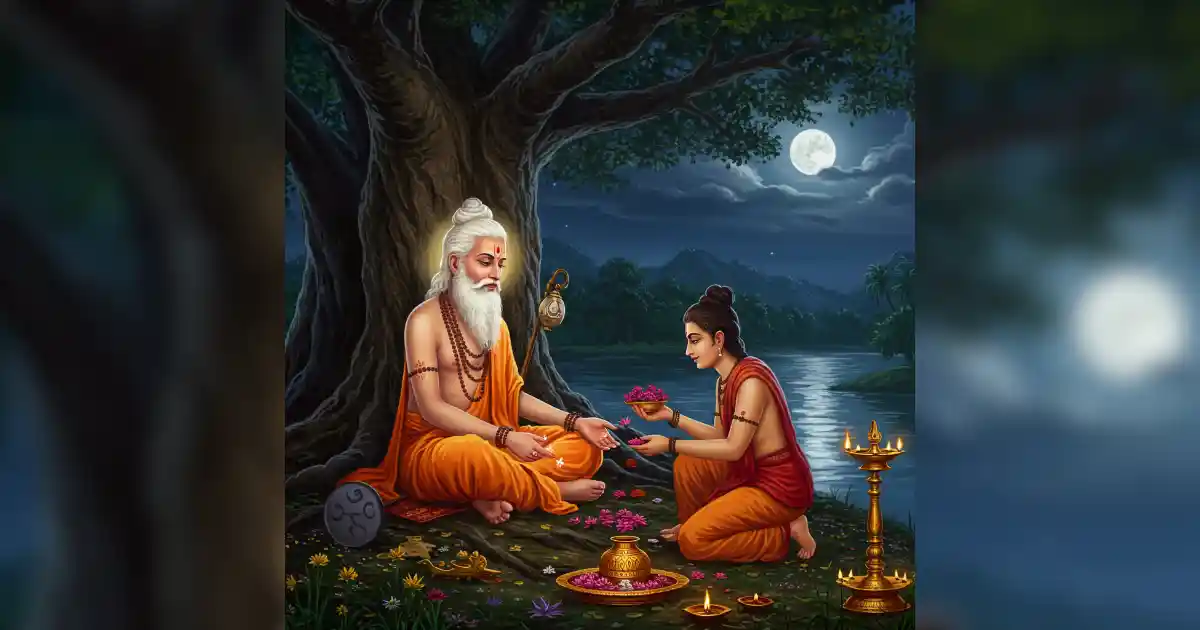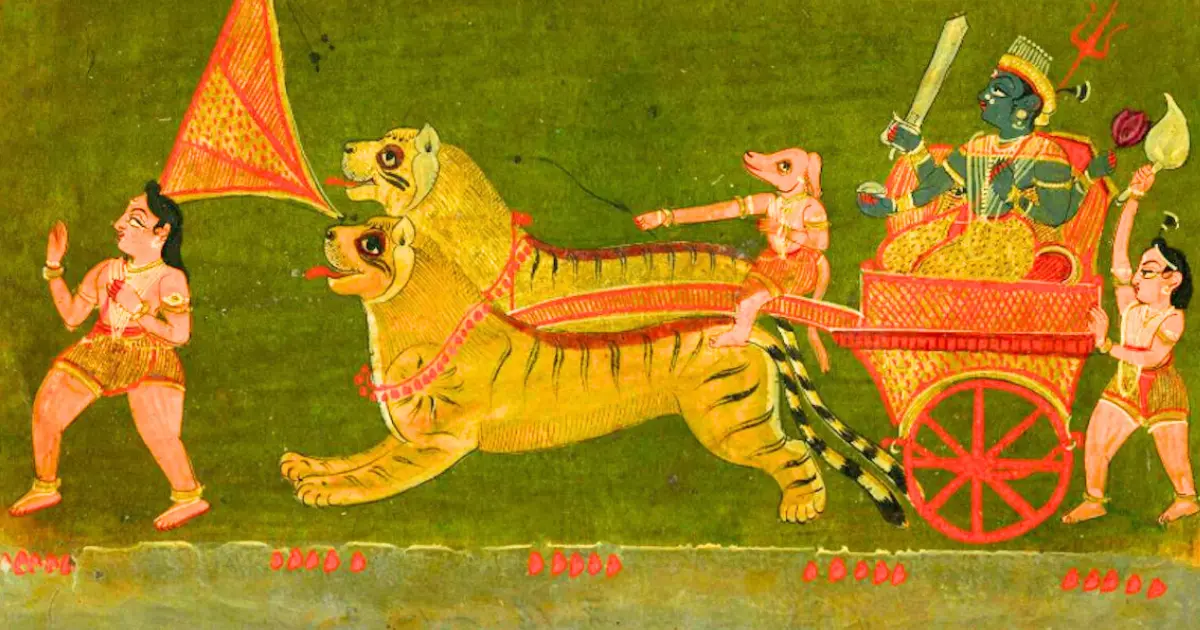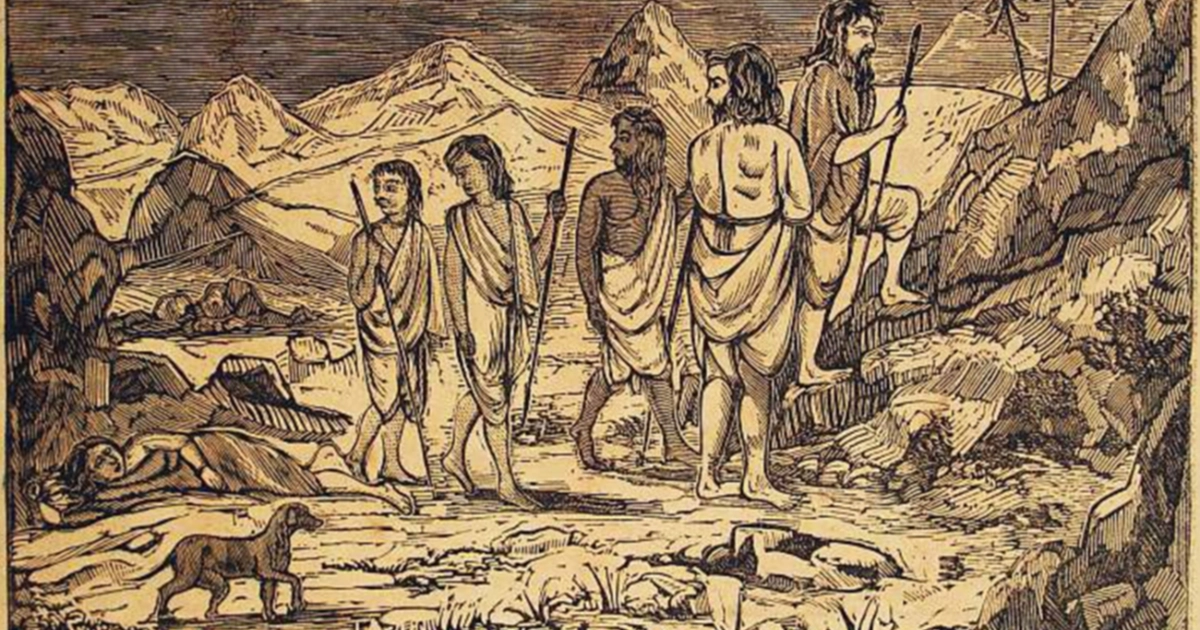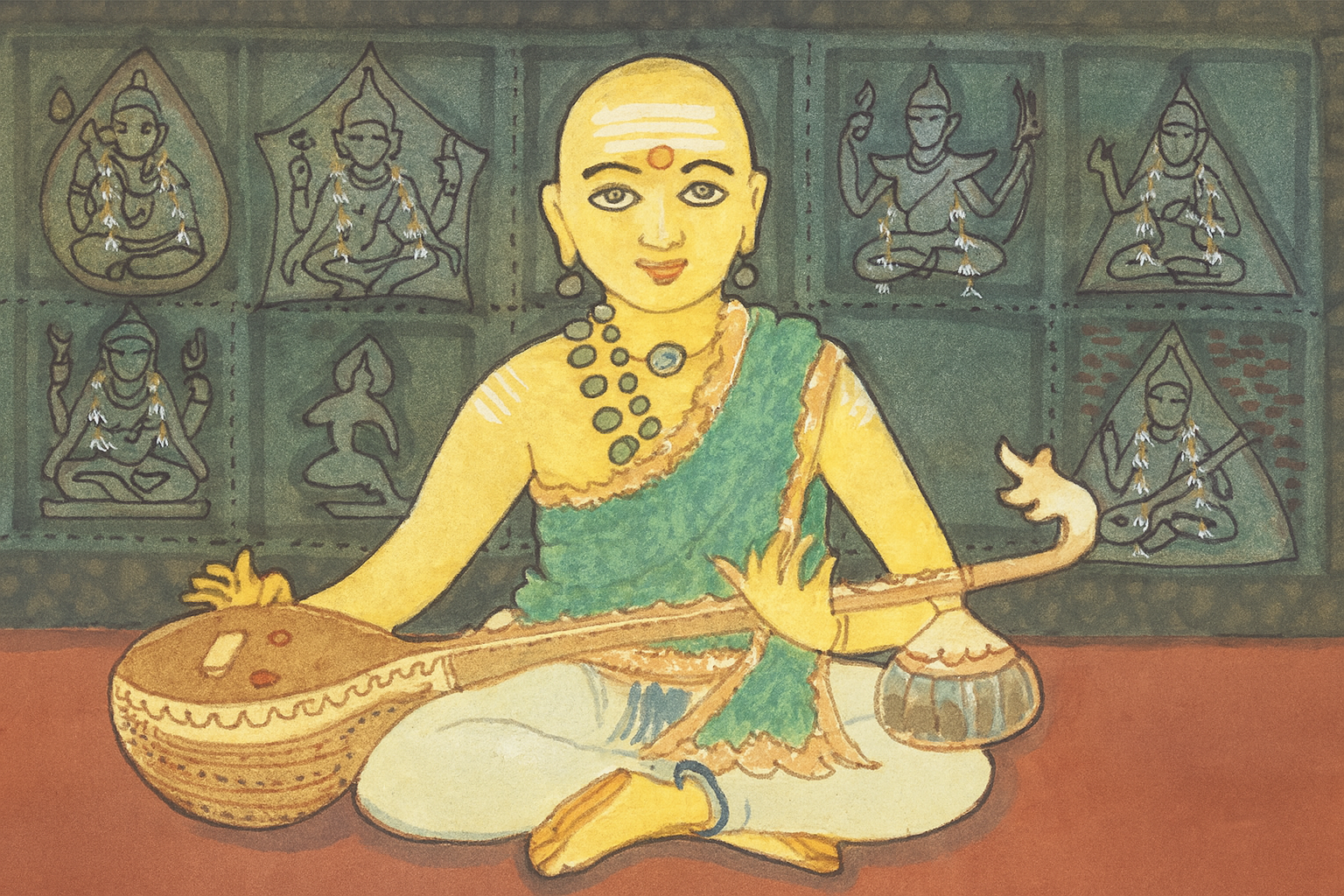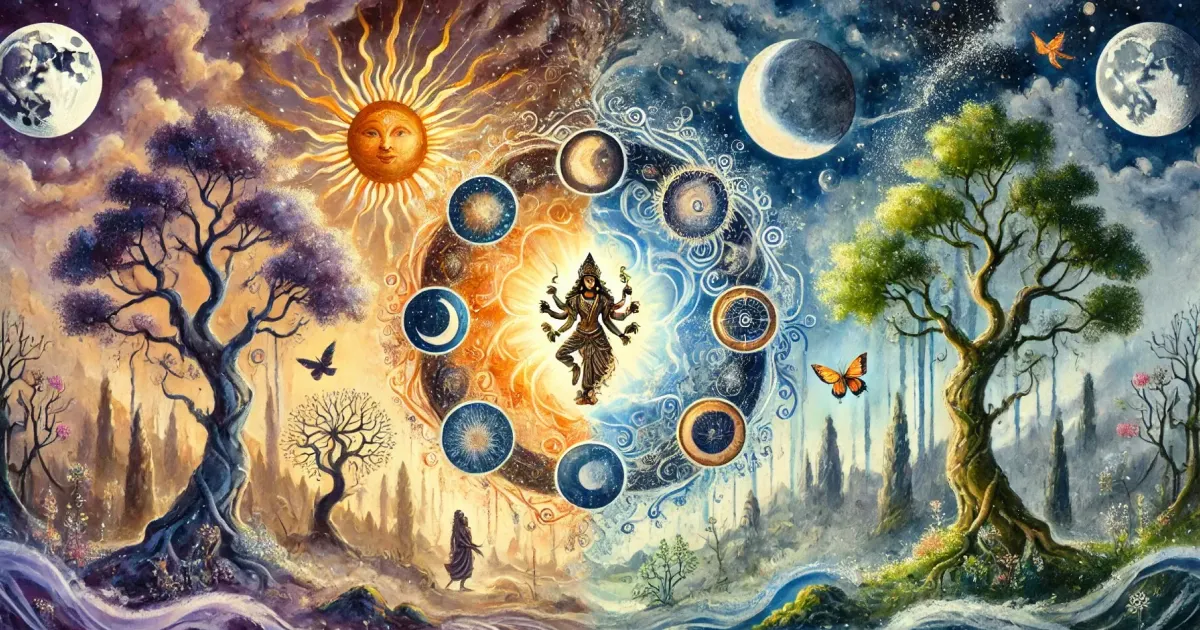Introduction
Bhārata is the land of Gurus and the unique continuity of tradition, culture, and civilizational knowledge and wisdom through the Guru-Śiṣya parampara. The Guru is the dispeller of the darkness of avidyā, leading us to the path of God realization and taking us towards mokṣa/liberation.
Guru Pūrṇimā, the day dedicated to venerating our Gurus, is also known as Vyāsa pūrṇimā, in honor of the appearance of the greatest of all Gurus, Veda Vyāsa. He is also believed to be one of the incarnations of Lord Viṣṇu, the organizer of the Vedas, as well as the author of the Upaniṣads, the Mahābhārata and Purāṇas. It is also believed that this was the day when Lord Śiva/Ādi Guru, or the first Guru, taught the seven ṛṣis/Saptaṛṣis the Vedas.
This day is of utmost importance for Saṃnyāsīs, as it is believed that the most suitable day for accepting saṃnyāsa is Pūrṇimā, the full moon day. Guru Pūrṇimā is also the day considered auspicious for Gurudakṣiṇā.
Guru Pūrṇimā/Vyāsa Pūjā is a ceremony observed on the full-moon day of the āṣāḍha month.
Significance
We see all our scriptures begin with a maṇgalācaraṇa which pays obeisance to the Guru.
Paṇḍit Rājeśvara Śāstrī Drāviḍa jī explains the objective behind this ‘Guru-bhaktī’, saying that even an ordinary student becomes extraordinary when he/she achieves the wealth of ‘Pratibhā’ (intuitive and creative genius) just by surrendering with utmost ‘Śhraddhā’ to the Guru and receiving his blessings.
Ācārya Kauṭilya in the Arthaśāstra makes a very clear point, that in order to become a great leader, one should possess ‘vinaya’(humility), which will only come by serving elders.
On the other hand, to incur the Guru’s śāpa was the end of everything good. We see that in the episode of Karṇa forgetting everything he learnt from Parśurāma when the latter found out that he lied to him about his background.
The Guru, the teacher can never be replaced even in the age of the internet and now, Artificial Intelligence. A Guru with his sheer presence in one’s life, transforms and helps one ascend to the higher truths.
Śrī Kṛṣṇa to Sudāmā in the Bhāgvatam says that nothing pleases one more than Guru bhaktī.
In the Kaliyuga, Guru bhaktī is even greater than Iśa-bhaktī as Dīkṣā (given only by a qualified Guru) is said to grant mokṣa to the initiate by destroying all his sins.
Scriptural references
Skanda Purāṇa - Guru Gīta
A famous verse that glorifies the Guru:
गुरुर्ब्रह्मा गुरुर्विष्णुः गुरुर्देवो महेश्वरः। गुरुस्साक्षात् परम्ब्रह्म तस्मै श्रीगुरवे नमः॥
The guru is Brahmā, Viṣṇu, and Maheśa, veneration to the Guru who is Parabrahman manifest.
The second line of the couplet, as explained by Paṇḍit Rājeśvara Śāstrī Drāviḍa jī means that one cannot see Īśvara with mortal eyes, but the Guru carrying all the knowledge which is passed on from the Gods themselves, is thus, a physical manifestation of the divine. Therefore, he should be venerated as such.
This is subtly illustrated by another famous verse:
गुरु गोविन्द दोऊ खड़े, काके लागूं पायें। बलिहारी गुरु आपने, जिन गोविंद दियो बताय॥
Guru and Govinda (Kṛṣṇa), are present before me, to whom shall I bow down first? Glory to the Guru since he showed me Govinda.
Apart from guiding the aspirant on the path to God-realization, the Guru throws light on the profound meanings of the vast array of scriptural knowledge. Hence, the Muṇḍaka Upaniṣad calls such a Guru Śrotriya - knower of the true meanings of the scriptures. Ādi Śaṇkarācārya forbids an aspirant from endeavoring to decipher the meanings without a Guru. In his commentary on a Mantṛa (1.2.13) of the Muṇḍaka Upaniṣad, he says: Even if one possesses knowledge of the scriptures, he should not attempt to delve into their meanings by himself. He should obtain the knowledge of Brahman only through the Guru.
In their treatises, other Ācāryas, such as Rāmanuja and Nimbaṛk, have considered the Guru mandatory for God-realization.
Muṇḍaka Upaniṣad (1.2.12–13)
tad vijñānārthaṁ sa gurum evābhigacchet samitpāṇiḥ śrotriyaṁ bramaniṣṭham
To attain That (Brahman), one must approach a Guru —who is learned in the Vedas and established in Brahman.
Chāndogya Upaniṣad
Uddālaka Āruṇi teaches Śvetaketu through the famous “tat tvam asi” mahāvākya. The father-son as Guru-śiṣya dynamic is deeply sacred.
Kaṭha Upaniṣad
Naciketā seeks knowledge of Ātman from Yama as a Guru.
Taittirīya Upaniṣad (1.11)
Includes the famous convocation address:
mātṛ devo bhava, pitṛ devo bhava, ācārya devo bhava
Regard your mother, father, and teacher as gods.
ṚgVeda
In the 10th Maṇdala, we see the Guru-Śiṣya relationship between Rishi Vasiṣṭha, the Rājpurohita of King Sudās, who leads the latter to victory against a confederation of ten Kings, in the Dasarājña war (The Battle of Ten Kings).
Vālmīki's Rāmāyaṇa
Rāma and his brothers are educated by Vasiṣṭha and Viśvāmitra, both of whom are treated with profound devotion and unquestioning obedience.
Rāma never disobeys the guidance of these sages, symbolizing the ideal śiṣya.
Hanuman’s clarity in speech and intelligence are attributed to his learning under Sūrya Deva as Guru.
His humility before Rāma also reflects the Guru-bhāva, seeing Rāma as a divine teacher.
Ahalyā tells Rāma that Viśvāmitra’s coming and Rāma’s darśan are part of her karmic liberation, once again affirming the Rishi or Guru’s role in mokṣa.
Mahābhārata
Droṇācārya is regarded with the utmost respect—even when he fights for the Kauravas, Arjuna and others treat him with śraddhā.
Bhīṣma acts as a spiritual guide for Yudhiṣṭhira in the Śānti Parva and Anuśāsana Parva, where he teaches Rājanīti, Dharma, and Mokṣa.
Śrī Kṛṣṇa becomes Arjuna’s Guru in the Bhagavad Gītā:
śiṣyas te ’haṁ śādhi māṁ tvāṁ prapannam” (BG 2.7)
I am your disciple; instruct me, I have taken refuge in you.
This turning point converts Kṛṣṇa from a charioteer to a divine Ācārya.
Bhagavad Gīta (4/34)
The disciple should humbly pose questions to the Guru and please him by serving him. He will then impart the knowledge of God, so ordain the wise sages.
Śrīmad Bhāgvatam
Bhagwān Ruṣabhdeva advocates for his sons: Obeying the Anuvṛtti - unvoiced wishes - of God and Guru is devotion.
Chaitanya Bhāgavata
In verse 2.5.8, Śrī Vyāsa-pūjā is a prescribed function for all four āśramas, but particularly the sannyāsīs should observe this function. Members of those sampradāyas in Āryāvarta that accept the teachings of Śrī Vyāsadeva are famous as vedānugas, or followers of the Vedas. Every year, they all worship their spiritual master on his appearance day.
The most suitable day for accepting sannyāsa is Pūrṇimā, the full moon day. Whether impersonalist or personalist, all sannyāsīs worship their spiritual masters. That is why Vyāsa-pūjā is generally celebrated on the full moon day of Āṣāḍha, which is considered the appearance day of the spiritual master. The servants of Śrī Gauḍīya Maṭha observe Śrī Vyāsa-pūjā every year on the fifth day of the waning moon in the month of Māgha (January-February) as a sign of respect. The observance of Śrī Vyāsa-pūjā differs in various branches. Since brāhmaṇas of all four āśramas who have undergone the prescribed purificatory processes are under the shelter of a spiritual master who represents Śrī Vyāsa, they more or less regularly worship Śrī Vyāsadeva as a prescribed duty; but the annual observance of Vyāsa-pūjā is the beginning of worshiping the spiritual master throughout the year. Another name for Śrī Vyāsa-pūjā is Śrī Guru-pāda-padme pādyārpaṇa, or “bathing the lotus feet of the spiritual master with five ingredients,” or the process by which it is made known that the inner desire of the spiritual master is to properly serve the Lord.
Srila Gurudeva (The Supreme Treasure)
Vyāsa-pūjā of the Bona Fide Guru
Śrī Vyāsa-pūjā is the most holy appearance day of Śrī Vyāsadeva and His representative, śrī guru. The real meaning of vyāsa-pūjā is to surrender oneself completely at śrīla gurudeva’s lotus feet and to fulfill his desires. Vyāsa-pūjā is guru-pūjā, and cannot be performed until the mood of selfless surrender at the lotus feet of śrī guru appears in one’s heart.
The factual meaning of vyāsa-pūjā is to follow the path of hearing the authentic message of the guru-paramparā that śrī guru delivers. This is called śrauta-patha. We should also reject any path wherein that message is not heard from an authentic source (aśrauta-patha). The purpose of vyāsa-pūjā is to prepare oneself for service to Śrī Hari under the guidance of the guru and Vaiṣṇavas.
“The word vyāsa refers to a line drawn through the centre of a circle, connecting opposite parts of the circle. Now, if we imagine that the transcendental spiritual world is at one side of the circle and the mundane material world is on the opposite point, the line that connects both worlds is vyāsa. Śrī Vyāsa is an incarnation of the Lord Himself, who delivers the transcendental knowledge of the spiritual realm to the mundane world.
Vyāsa-pūjā, the appearance day of Śrīla Vyāsadeva, is respectfully observed in all the four sampradāyas.
Celebrations
In the South
It is a ceremony more important to the sannyāsīs (ascetics) and others who have renounced the world than to the worldly-minded men. What renunciation of the world really means is that those who have renounced the world have no restricted sympathies, affections, and responsibilities which worldly men have in the shape of family ties and responsibilities, etc. They have, in fact, responsibilities for the welfare of humanity as a whole. Hence, the sannyāsīs and others, who have renounced the world and its pleasures, perform Vyāsa Pūjā to draw down on humanity the blessings of the mighty sage Vyāsa. The author of the famous Indian epic Mahābhārata.
The mode of observance of this pūjā.—Rice is spread on a piece of new cloth, and over the rice are placed lime fruits to draw the presence of Ādi Śankara and his four disciples. After the pūjā ceremony is over, the rice is distributed to people to be taken home and mixed with the stock kept there.
In Braj (Uttar Pradesh)
On the day of vyāsa-pūjā, all Vrajavāsi men shave their heads, keeping only a small tuft of hair called a śikhā, and they perform parikramā of Śrī Govardhana hill, as Śrīla Sanātana Gosvāmī would do daily. Once, when Śrīla Sanātana Gosvāmī was performing Govardhana parikramā in his old age, he became faint with fatigue due to the blazing heat of summer. Śrī Kṛṣṇa and Śrī Baladeva Themselves appeared there as two transcendental cowherd boys. Śrī Kṛṣṇa used His own yellow cloth (pītāmbara) to shade Śrīla Sanātana Gosvāmī, while Śrī Baladeva used his own blue cloth (nīlāmbara) to fan him. They also sprinkled water on him, and when he came to external consciousness, Śrī Kṛṣṇa told him that there was no need for him to keep doing Govardhana parikramā and undergoing so much hardship in his old age. Sanātana said, “How can I give it up? This is my vow. As long as I am alive in this world, I will do Govardhana parikramā.” Śrī Kṛṣṇa then gave him a śilā of Girirāja Govardhana, with the divine impressions of His right footprint, flute, cow-grazing stick, and an auspicious imprint of a calf’s hoofprint. Śrī Kṛṣṇa told Śrīla Sanātana Gosvāmī that if he performed parikramā of this śilā four times, it would be equal to an entire parikramā of Girirāja Govardhana. After giving the śilā to Śrīla Sanātana Gosvāmī, the boys disappeared. This śilā now resides in the temple of Śrī Śrī rādhā-Dāmodara in Sevā-kuñja, Vṛndāvana, and if one requests the temple’s pūjārī, one may receive a special darśana of the śilā.
Many people come to see the Lord, but few can understand the glories of the Lord’s pure devotee, who captures the Lord by his unalloyed devotion. Just as the Lord came to Śrīla Sanātana Gosvāmī, He also comes to all His pure, unalloyed devotees; therefore, we should hear hari-kathā from such realized souls, and serve them wholeheartedly. When Śrīla Sanātana Gosvāmī disappeared from this world, the Vrajavāsis took his transcendental body and placed him in samādhi in Vṛndāvana, near Rādhā-Madana-mohana temple, where he used to live.
On the appearance day of Śrīla Vyāsadeva, all the sampradāyas–Śrī sampradāya, Brahma sampradāya, rudra sampradāya and Sanak sampradāya–perform vyāsa-pūjā (guru-pūja). In the Gauḍīya sampradāya, we observe the appearance day of Śrīla Vyāsadeva with the unique feature that we also observe the vyāsa-pūjā, or the appearance day, of our own guru.
As soon as the living entity’s material enjoyment is vanquished, he approaches an ācārya and takes shelter of his lotus feet. Taking shelter at the lotus feet of an ācārya in this way is the real meaning of the term Vyāsa-pūjā. Śrī Vyāsa-pūjā is a prescribed function for all four āśramas, but particularly the sannyāsīs should observe this function.
Members of those sampradāyas in Āryāvarta that accept the teachings of Śrī Vyāsadeva are famous as vedānugas, or followers of the Vedas. Every year, they all worship their spiritual master on his appearance day. The most suitable day for accepting sannyāsa is Pūrṇimā, the full moon day. Whether impersonalist or personalist, all sannyāsīs worship their spiritual masters. That is why Vyāsa-pūjā is generally celebrated on the full moon day of Āṣāḍha, which is considered the appearance day of the spiritual master. The servants of Śrī Gauḍīya Maṭha observe Śrī Vyāsa-pūjā every year on the fifth day of the waning moon in the month of Māgha (January-February) as a sign of respect. The observance of Śrī Vyāsa-pūjā differs in various branches. Since brāhmaṇas of all four āśramas who have undergone the prescribed purificatory processes are under the shelter of a spiritual master who represents Śrī Vyāsa, they more or less regularly worship Śrī Vyāsadeva as a prescribed duty; but the annual observance of Vyāsa-pūjā is the beginning of worshiping the spiritual master throughout the year. Another name for Śrī Vyāsa-pūjā is Śrī Guru-pāda-padme pādyārpaṇa, or “bathing the lotus feet of the spiritual master with five ingredients,” or the process by which it is made known that the inner desire of the spiritual master is to properly serve the Lord. That is why our well-wishing guide and predecessor spiritual master Śrīla Ṭhākura Narottama has glorified our primary guru, Śrī Rūpa Gosvāmī, as follows:
śrī-caitanya-mano-’bhīṣṭaṃ sthāpitaṃ yena bhū-tale svayaṃ rūpaḥ kadā mahyaṃ dadāti sva-padāntikam
Performing Guru Puja at home
One should wake up early along with sunrise and take a bath. Adorn new clothes. Set up an altar with your Guru’s image and light a lamp. Offer flowers, fruits, incense and other auspicious items to your Guru and recite the Guru mantṛa. Perform the ārati with bhajans dedicated to your Guru. At the end, seek the Guru’s blessings in every endeavour and distribute the prasāda to family and friends.
Conclusion
The oral tradition of the Vedas relies entirely on the Guru-Śiṣya paramparā.
True knowledge is never attained through mere reading but through śravaṇa, manana, and nididhyāsana under the guidance of a realized Guru.
In each of our texts, we see the Guru’s presence as foundational as he instructs, illuminates, guides and even takes action to further the course of events to uphold ‘Dharma’.
In contemporary times too, we see this with the examples of Chhatrapati Mahārāj Śivājī and his guru Samarth Rāmdas, Guru Gobind Singh and Bandā Bahādur, Vidyaranya and Hakkā and Bukkā, who established the invincible Vijayanagara empire – the list is endless.
The core message is that – The Guru is Dharma himself, and so is irreplaceable.
References
- Significance Of Gurubhakti In Statecraft As Per Artha Shastra Commentaries | Dr. J Srinivas
- Why Guru Purnima Is Unique To Hindu Dharma
- https://www.jstor.org/stable/3269931
- https://www.wisdomlib.org/hinduism/book/chaitanya-bhagavata/d/doc1104711.html
- https://www.shriaghoreshwar.org/en/guru-gita-3/
- https://www.swaminarayan.org/festivals/gurupurnima/index.htm#:~:text=Skanda%20Purana%20%2D%20Guru%20Gita&text=The%20second%20line%20of%20the,Guru%20mandatory%20in%20God%2Drealization.
- https://www.wisdomlib.org/hinduism/book/chaitanya-bhagavata/d/doc1104711.html https://www.wisdomlib.org/hinduism/book/srila-gurudeva-the-supreme-treasure/d/doc1210513.html
- https://www.wisdomlib.org/definition/vyasapuja#history
- https://www.wisdomlib.org/hinduism/book/srila-gurudeva-the-supreme-treasure/d/doc1210513.html
- https://www.wisdomlib.org/hinduism/book/chaitanya-bhagavata/d/doc1104711.html https://www.siddhayoga.org/practices/guru-puja
- Guru-Diksha-Moksha: The Triad In Tantragama By Dr. Ketu Ramachandrasekhar
- Guru, Anantakoti Brahmanda Nayak | P.P. Shri Shamsundar Deshpande Maharaj
